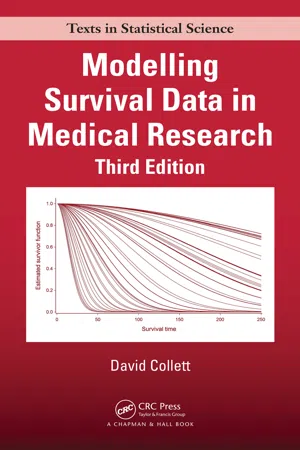
- 548 pages
- English
- PDF
- Available on iOS & Android
eBook - PDF
Modelling Survival Data in Medical Research
About this book
Modelling Survival Data in Medical Research describes the modelling approach to the analysis of survival data using a wide range of examples from biomedical research.Well known for its nontechnical style, this third edition contains new chapters on frailty models and their applications, competing risks, non-proportional hazards, and dependent censo
Frequently asked questions
Yes, you can cancel anytime from the Subscription tab in your account settings on the Perlego website. Your subscription will stay active until the end of your current billing period. Learn how to cancel your subscription.
At the moment all of our mobile-responsive ePub books are available to download via the app. Most of our PDFs are also available to download and we're working on making the final remaining ones downloadable now. Learn more here.
Perlego offers two plans: Essential and Complete
- Essential is ideal for learners and professionals who enjoy exploring a wide range of subjects. Access the Essential Library with 800,000+ trusted titles and best-sellers across business, personal growth, and the humanities. Includes unlimited reading time and Standard Read Aloud voice.
- Complete: Perfect for advanced learners and researchers needing full, unrestricted access. Unlock 1.4M+ books across hundreds of subjects, including academic and specialized titles. The Complete Plan also includes advanced features like Premium Read Aloud and Research Assistant.
We are an online textbook subscription service, where you can get access to an entire online library for less than the price of a single book per month. With over 1 million books across 1000+ topics, we’ve got you covered! Learn more here.
Look out for the read-aloud symbol on your next book to see if you can listen to it. The read-aloud tool reads text aloud for you, highlighting the text as it is being read. You can pause it, speed it up and slow it down. Learn more here.
Yes! You can use the Perlego app on both iOS or Android devices to read anytime, anywhere — even offline. Perfect for commutes or when you’re on the go.
Please note we cannot support devices running on iOS 13 and Android 7 or earlier. Learn more about using the app.
Please note we cannot support devices running on iOS 13 and Android 7 or earlier. Learn more about using the app.
Yes, you can access Modelling Survival Data in Medical Research by David Collett in PDF and/or ePUB format, as well as other popular books in Mathematics & Probability & Statistics. We have over one million books available in our catalogue for you to explore.
Information

16
SURVIVAL
ANALYSIS
The
use
of
S-PLUS
in
survival
analysis
is
also
described
in
Everitt
and
Rabe-
Hesketh
(2001)
and
Tableman
and
Kim
(2004),
while
Brostr¨om
(2012)
shows
how
R
is
used
in
the
analysis
of
survival
data.
Venables
and
Ripley
(2002)
describe
how
graphical
and
numerical
data
analyses
can
be
carried
out
in
the
S
environment
that
is
implemented
in
both
R
and
S-PLUS;
note
that
S
code
generally
runs
under
R.
A
similarly
comprehensive
account
of
the
R
system
is
given
by
Crawley
(2013),
while
Dalgaard
(2008)
gives
a
more
elementary
introduction
to
R.
The
short
introduction
to
R
of
Venables
and
Smith
(2009)
is
also
available
from
R
Core
Team
(2013).
The
use
of
Stata
in
survival
analysis
is
presented
by
Cleves
et
al.
(2010),
and
Rabe-Hesketh
and
Everitt
(2007)
give
a
more
general
introduction
to
the
use
of
Stata
in
data
analysis.
Table of contents
- Front Cover
- Contents
- Preface
- Chapter 1: Survival analysis
- Chapter 2: Some non-parametric procedures
- Chapter 3: The Cox regression model
- Chapter 4: Model checking in the Cox regression model
- Chapter 5: Parametric proportional hazards models
- Chapter 6: Accelerated failure time and other parametric models
- Chapter 7: Model checking in parametric models
- Chapter 8: Time-dependent variables
- Chapter 9: Interval-censored survival data
- Chapter 10: Frailty models
- Chapter 11: Non-proportional hazards and institutional comparisons
- Chapter 12: Competing risks
- Chapter 13: Multiple events and event history modelling
- Chapter 14: Dependent censoring
- Chapter 15: Sample size requirements for a survival study
- Appendix A: Maximum likelihood estimation
- Appendix B: Additional data sets
- Bibliography
- Back Cover